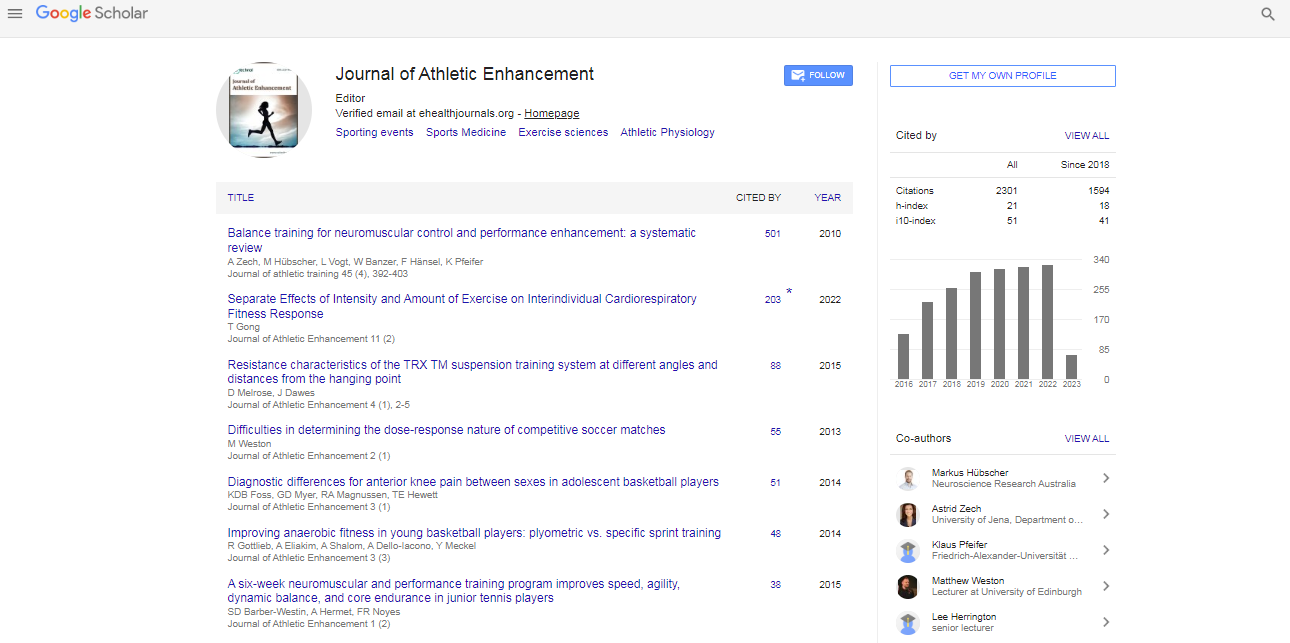Commentary, J Athl Enhanc Vol: 13 Issue: 4
Understanding Sport Concussion and its Prevention Strategies
John Roman*
Department of Sport Sciences, University of Lausanne, Lausanne, Switzerland
*Corresponding Author: John Roman,
Department of Sport Sciences, University
of Lausanne, Lausanne,
Switzerland;
E-mail: romanjoh_n@unil.ch
Received date: 28 June, 2024, Manuscript No. JAE-24-144898;
Editor assigned date: 01 July, 2024, PreQC No. JAE-24-144898 (PQ);
Reviewed date: 15 July, 2024, QC No. JAE-24-144898;
Revised date: 22 July, 2024, Manuscript No. JAE-24-144898 (R);
Published date: 29 July, 2024 DOI: 10.4172/2324-9080.1000135
Citation: Roman J (2024) Understanding Sport Concussion and its Prevention Strategies. J Athl Enhanc 13:4.
Description
Concussions in sports have garnered significant attention over recent years due to increased awareness of their potential long-term effects and their impact on athletes' health. A concussion is a form of Traumatic Brain Injury (TBI) caused by a blow to the head or body that shakes the brain within the skull. This injury disrupts normal brain function, leading to various physical, cognitive and emotional symptoms. Understanding the nature of concussions, their prevention and their management is important for safeguarding athletes at all levels of competition.
A concussion occurs when a forceful impact causes the brain to move rapidly back and forth within the skull. This movement can stretch and damage brain cells, leading to a series of biochemical changes that impair brain function. Symptoms of a concussion can vary widely and may include headache, dizziness, confusion and nausea, sensitivity to light or noise and memory problems. In some cases, symptoms may not appear immediately, making it essential for athletes, coaches and medical professionals to be vigilant.
Recent research has shed light on the complex nature of concussions. The injury can affect different brain regions and systems, leading to a broad spectrum of symptoms. Moreover, repeated concussions or a single concussion that is not properly managed can lead to Chronic Traumatic Encephalopathy (CTE), a progressive neurodegenerative disease associated with severe cognitive decline, mood disorders and other neurological issues.
Prevention strategies of sport concussion
Preventing concussions is a multifaceted challenge that involves both education and implementation of safety measures. Several strategies can help reduce the incidence of concussions in sports
Education and awareness: Educating athletes, coaches and parents about the signs and symptoms of concussions is important. Awareness programs can help ensure that everyone involved in sports understands the importance of reporting head injuries and the potential consequences of playing while concussed.
Proper equipment: Using appropriate and well-fitted protective equipment can reduce the risk of concussions. For example, in sports like football and hockey, helmets play a critical role in protecting against head injuries. However, it's important to note that while helmets can reduce the risk of certain types of head injuries, they cannot completely prevent concussions.
Rule changes and modifications: Modifying rules and regulations to minimize high-risk situations can be effective. For instance, in contact sports, enforcing rules that limit aggressive behavior and penalize dangerous plays can reduce the incidence of concussions.
Technique and training: Training athletes in proper techniques for tackling, blocking and other potentially hazardous manoeuvres can help reduce the risk of head injuries. Proper technique not only improves performance but also enhances safety.
Concussions are a serious concern in sports, with potential shortterm and long-term effects on athletes' health and well-being. Understanding the nature of concussions, implementing preventive measures and following proper management protocols are critical steps in addressing this issue. By raising a culture of awareness, promoting safe practices and ensuring appropriate medical care, we can enhance the safety of athletes and support their recovery from concussions. As research continues to advance, on-going efforts to improve concussion prevention and management will play a vital role in safeguarding the future of sports.
 Spanish
Spanish  Chinese
Chinese  Russian
Russian  German
German  French
French  Japanese
Japanese  Portuguese
Portuguese  Hindi
Hindi 
